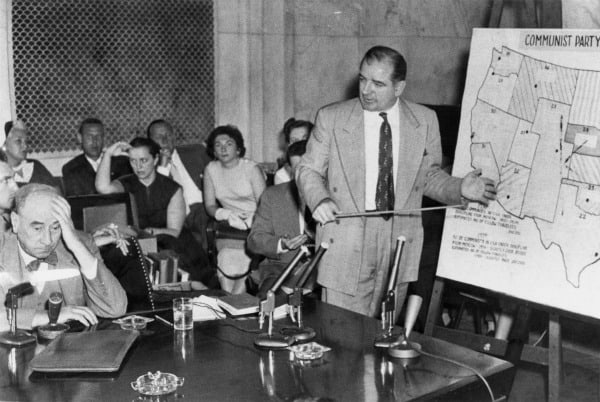In the late 1930s, faced with economic uncertainties and political unrest in Europe, the US House of Representatives established the House Un-American Activities Committee. Known as HUAC, the committee took upon itself the protection of America from subversives, especially communists. Any citizen could find himself or herself under investigation. Any citizen could be brought before the committee and forced to testify. Constitutional protections from the First and Fifth Amendments bore no weight with the committee. Those who exercised them before the committee could be, and many were, cited for contempt of Congress. A contempt finding carried with it financial penalties as well as jail time.

When the HUAC turned its attention to the entertainment industry in the 1940s, it drew many famous names into its activities. Walt Disney published a letter in Variety Magazine, blaming communist agitators for a strike which impacted his studio. Subsequent investigations by Los Angeles prosecutors named Humphrey Bogart, Katherine Hepburn, James Cagney, and other stars of equal stature as possible communist sympathizers. Their names, and the potential press exposure generated by calling such luminaries to testify before the committee proved irresistible to grandstanding politicians in Congress. Later, television enhanced the spotlight on the intrepid congressmen rooting out communist subversives in Hollywood. Reputations, careers, fortunes, and lives were ruined. Here is the story of Hollywood and the HUAC.

1. Martin Dies Jr. used the committee to further his political agenda
The first chairman of the HUAC, then called the Dies Committee, was an anti-New Deal Democrat named Martin Dies Jr. In the mid-to-late 1930s he led the committee to focus on American pro-Nazi groups, as well as the Ku Klux Klan. When the Molotov-Ribbentrop Pact between Germany and the Soviet Union became known, he expanded the committee’s work into American support of communism, particularly in labor unions. He received a list of Hollywood stars who had sent messages of support to a French newspaper, Ce Soir (This Evening). Dies issued a statement which identified Ce Soir as being wholly owned by the Communist Party in France. He released a list of names famous to Americans, identifying them as having sent “greetings” to the newspaper, implying they were communist sympathizers.
Among the names on the list were James Cagney, Robert Taylor, and Hollywood’s leading male star at the time, Clark Gable. This took place the year before Gable appeared in his most famous role as Rhett Butler in Gone With the Wind. Another name on the list was the girl known as America’s “sweetheart” at the time, Shirley Temple. Temple was all of ten years of age when her name first appeared in the context of being a communist sympathizer. Dies gained public attention, which helped him push his ant-New Deal agenda in Congress, in particular his opposition to Roosevelt’s labor programs. The Roosevelt administration responded with a statement ridiculing the Dies Committee’s findings regarding Hollywood. Secretary of the Interior Harold Ickes said, “They (the committee) have found dangerous radicals there led by little Shirley Temple”. A three-decade conflict involving Hollywood and HUAC began.

